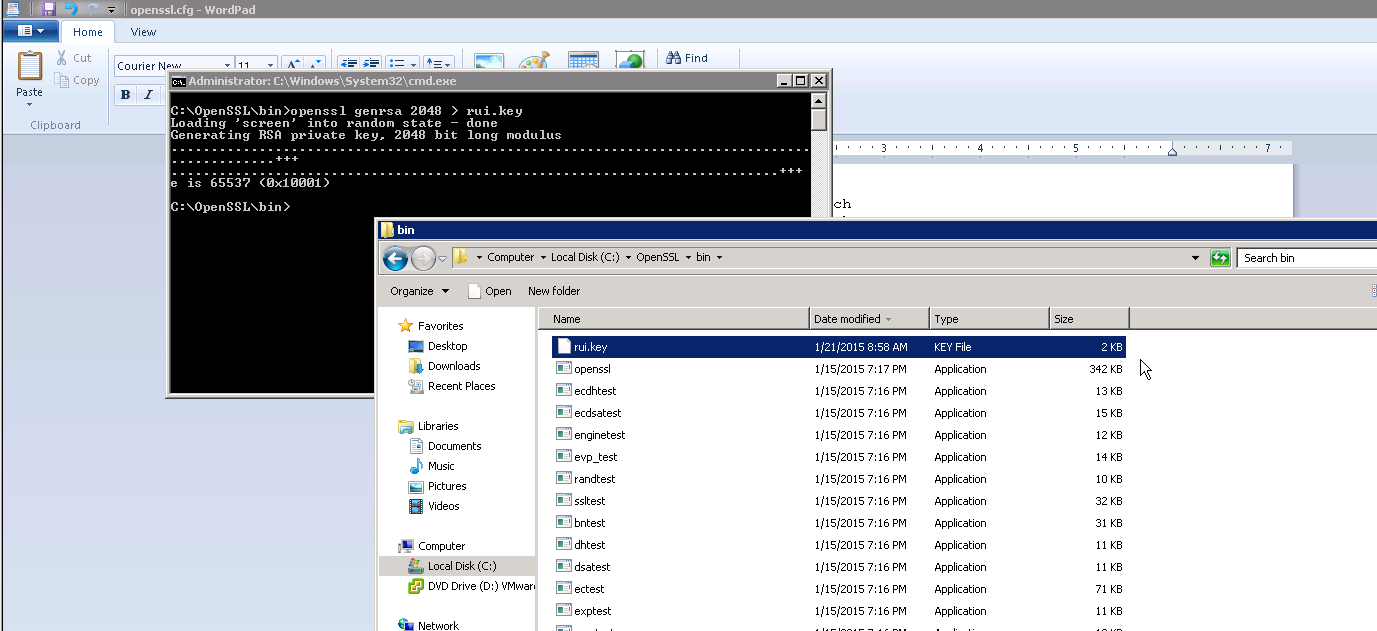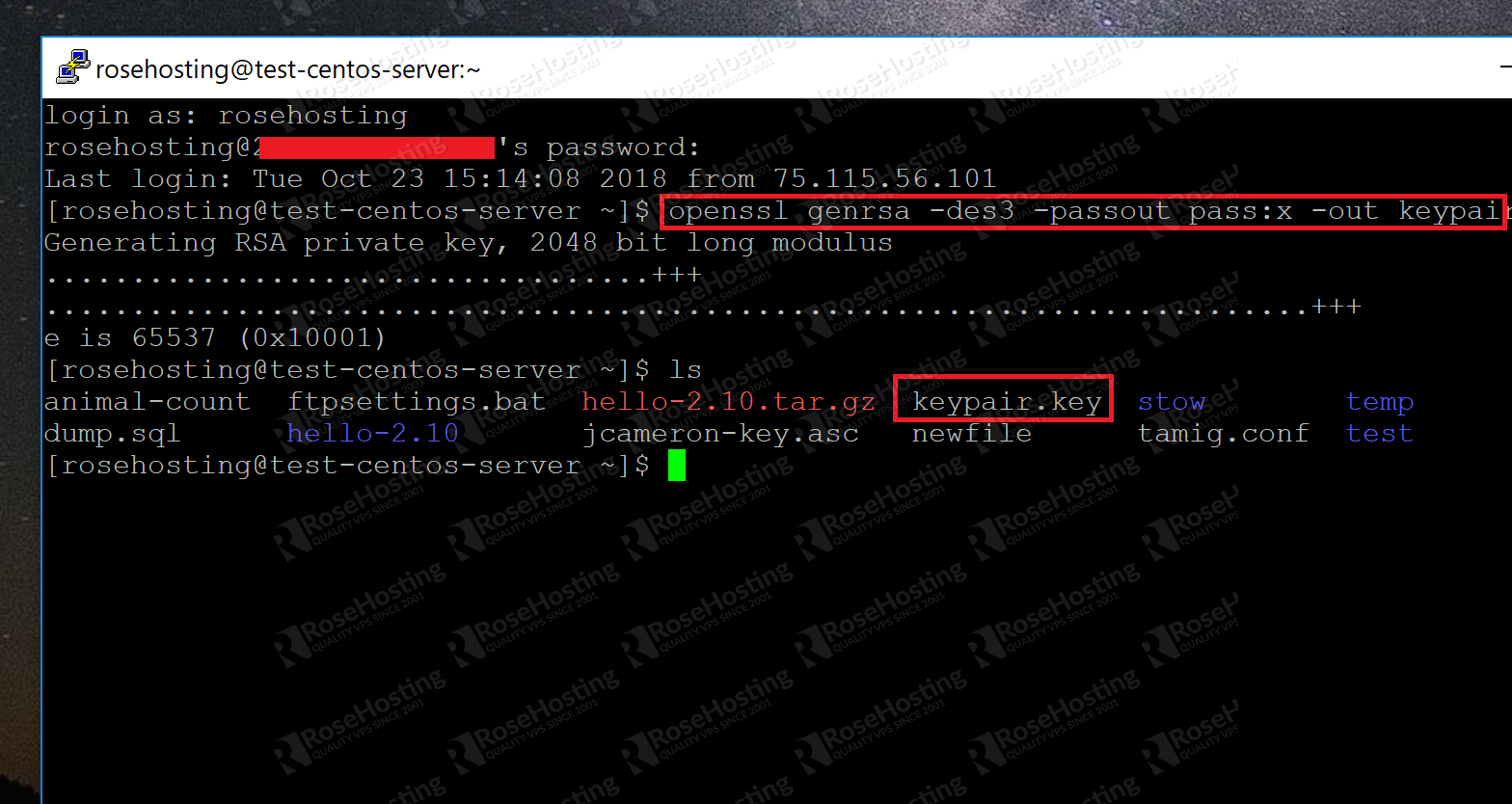- Apr 12, 2020 All the commands and steps will remain the same as we used above to generate self signed certificate, the only difference would be that we will not use any encryption method while we create private key in step 1. Openssl generate private key. In this example with openssl genrsa we will not use any encryption.
- Open a terminal and browse to a folder where you would like to generate your keypair. Windows Users: Navigate to your OpenSSL 'bin' directory and open a command prompt in the same location. Generate a CSR & Private Key: openssl req -out CSR.csr -new -newkey rsa:2048 -keyout privatekey.key.
- How to Use OpenSSL to Generate RSA Keys in C/C Xiao Ling / February 27, 2014 October 29, 2019 / Security / C/C, OpenSSL, RSA 5 comments It is known that RSA is a cryptosystem which is used for the security of data transmission.
- Generate Rsa Key Openssl C++
- Private Key Definition
- Openssl Generate Private Key C++
- Generate Private Key Openssl C 10
- Private Key Bitcoin
Common OpenSSL Commands with Keys and Certificates
Generate RSA private key with certificate in a single command
I am trying to implement the program to generate CSR using openssl and c. I need to implement the following commands using C. Generate CSR and private key with password with OpenSSL. Why is generating Certificate Signing Request (CSR) supposed to be platform/machine specific? Can't generate a CSR request with CA set to true. Encrypting Files with openssl / Programming in C/C / Security / Encrypting Files with openssl. Good resources. Generating a key pair. Generate private key openssl genrsa -out privatekey.pem 1024 Then use it to generate the public key openssl rsa -in privatekey.pem -out publickey.pem -outform PEM -pubout Encrypt file. Generating the Private Key - Linux 1. Open the Terminal. Navigate to the folder with the ListManager directory. Type the following: openssl genrsa -out rsa.private 1024 4. The private key is generated and saved in a file named 'rsa.private' located in the same folder. Generating the Public Key - Linux 1. Open the Terminal.
Generate Certificate Signing Request (CSR) from private key with passphrase
Generate RSA private key (2048 bit)
Generate a Certificate Signing Request (CSR)
Generate RSA private key (2048 bit) and a Certificate Signing Request (CSR) with a single command
Convert private key to PEM format
Generate a self-signed certificate that is valid for a year with sha256 hash
View details of a RSA private key
View details of a CSR
View details of a Certificate
View details of a Certificate in DER format

Convert a DER file (.crt .cer .der) to PEM
Convert a PEM file to DER
- Related Questions & Answers
- Selected Reading
OpenSSL is a CLI (Command Line Tool) which can be used to secure the server to generate public key infrastructure (PKI) and HTTPS. This article helps you as a quick reference to understand OpenSSL commands which are very useful in common, and for everyday scenarios especially for system administrators.
Certificate Signing Requests (CSRs)
If we want to obtain SSL certificate from a certificate authority (CA), we must generate a certificate signing request (CSR). A CSR consists of mainly the public key of a key pair, and some additional information. Both these components are merged into the certificate whenever we are signing for the CSR.
While generating a CSR, the system will prompt for information regarding the certificate and this information is called as Distinguished Name (DN). The important field in the DN is the Common Name (CN) which should be the FQND (Fully Qualified Domain Name) of the server or the host where we intend to use the certificate with.
The next item in a DN is to provide the additional information about our business or organization. If we purchase an SSL certificate from a certificate authority (CA), it is very important and required that these additional fields like “Organization” should reflect your organization for details.
Here is a general example for the CSR information prompt, when we run the OpenSSL command to generate the CSR.
We can also provide the information by non-interactive answers for the CSR information generation, we can do this by adding the –subj option to any OpenSSL commands that we try to generate or run.
Below is an example for the –subj option where we can provide the information of the organization where we want to use this CSR.
Generating CSRs
In this section, we will cover about OpenSSL commands which are related to generating the CSR. This CSR can be used to request an SSL certificate from a certificate authority.
Generate a Private Key and a CSR
If we want to use HTTPS (HTTP over TLS) to secure the Apache or Nginx web servers (using a Certificate Authority (CA) to issue the SSL certificate). Also, the ‘.CSR’ which we will be generating has to be sent to a CA for requesting the certificate for obtaining CA-signed SSL.
Below is the command to create a 2048-bit private key for ‘domain.key’ and a CSR ‘domain.csr’ from the scratch.
The ‘–newkey rsa:2048’ is the option which we are specifying that the key should be 2048-bit using the RSA algorithm. The ’ –nodes’ option is to specifying that the private key should not be encrypted with a pass phrase. The ‘-new’ option, indicates that a CSR is being generated.
Generate a CSR from an Existing Private Key
Here we will learn about, how to generate a CSR for which you have the private key.
Below is the command to create a new .csr file based on the private key which we already have.
Generate a CSR from an Existing Certificate and Private key
Here we can generate or renew an existing certificate where we miss the CSR file due to some reason. Here, the CSR will extract the information using the .CRT file which we have.
Below is the example for generating –
Where -x509toreq is specified that we are using the x509 certificate files to make a CSR.
Generating a Self-Singed Certificates
Here we will generate the Certificate to secure the web server where we use the self-signed certificate to use for development and testing purpose.
Here, we generate self-signed certificate using –x509 option, we can generate certificates with a validity of 365 days using –days 365 and a temporary .CSR files are generated using the above information.
Viewing the Certificates Files
Please note that, CSR files are encoded with .PEM format (which is not readable by the humans). This is required to view a certificate. In this section, we can cover the OpenSSL commands which are encoded with .PEM files.
Viewing CSR Files Entires
The below command will be used to view the contents of the .CRT files Ex (domain.crt) in the plain text format.
Working with Private Keys
Generate Rsa Key Openssl C++
In this section, will see how to use OpenSSL commands that are specific to creating and verifying the private keys.
Private Key Definition

Create a Private Key
Below is the command to create a password-protected and, 2048-bit encrypted private key file (ex. domain.key) –
Openssl Generate Private Key C++
Enter a password when prompted to complete the process.
Verify a Private Key
/generate-ssh-key-pair-openssl.html. Below is the command to check that a private key which we have generated (ex: domain.key) is a valid key or not
Generate Private Key Openssl C 10
If the private key is encrypted, you will be prompted to enter the pass phrase. Upon the successful entry, the unencrypted key will be the output on the terminal.
Private Key Bitcoin
In this article, we have learnt some commands and usage of OpenSSL commands which deals with SSL certificates where the OpenSSL has lots of features. We will learn more features and usage in the future. I hope this article will help us to understand some basic features of the OpenSSL. Generate rsa keys in linux.